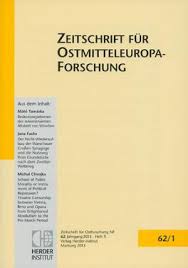Im Schatten des polnischen Staates: Pogrome 1918-1920 und 1945/46 - Auslöser, Bezugspunkte, Verlauf
In the Shadow of the Polish State: Pogroms in 1918-1920 and 1945/46. Triggers, Points of Reference, Sequence of Events
Author(s): Eva RederSubject(s): Jewish studies, Military history, Political history, Social history, Pre-WW I & WW I (1900 -1919), Interwar Period (1920 - 1939), WW II and following years (1940 - 1949)
Published by: Verlag Herder-Institut
Keywords: Polish State; Pogroms; 1918-1920 and 1945/46;
Summary/Abstract: This paper investigates pogroms in Poland, comparing the periods 1918-20 and 1945/46. Although representing different phases in Polish history, both periods show similarities and continuities (and also differences) in terms of both structural setting and pogrom violence. Both phases witnessed an exceptionally large number of pogroms, and in both cases profound socio-political ruptures and paradigm shifts took place, whereby the need to create enemies and personalize evil was tremendous. Pogrom triggers correlated with rumours of supposed Jewish aggression, be it murdering children for religious purposes, shooting at Polish soldiers or siding with Poland’s enemies. As such, these triggers reflect deeply upon the representation of the Jewish victims, but even more so upon the perpetrators and, indeed, Polish society itself, since the perpetrators were often perceived as executioners of public opinion or as defenders of the national interest. In order to understand pogrom triggers, it is helpful to take a close look at the course of events. The events the pogromists refer to are crucial for exculpating the pogrom afterwards, due to the fact that pogroms entail a high degree of public violence. In both reference periods, pogrom violence closely referred to the establishment of Polish statehood, even though this happened under divergent circumstances. An examination of the perpetrators’ discourses during and after the pogrom allows us to identify their symbolic reference points, which express both rumours and stereotypes about the Jewish victim-group, and which also show how the pogromists defined their relations towards state authorities. Indeed, the pogromists’ links with establishing statehood are decisive, as pogrom violence was justified as an action for or against the state leadership and state representatives, with policemen and soldiers being the most common grouping among the perpetrators. The pogroms are reconstructed by means of eyewitness accounts, military records and court files. The relevant sources are located at the Jewish Historical Institute, in the Central State Military Archives, and in the Archive of New Files in Warsaw. Further relevant holdings are to be found in the Central Historical State Archives of the City of Lviv.
Journal: Zeitschrift für Ostmitteleuropa-Forschung
- Issue Year: 60/2011
- Issue No: 4
- Page Range: 571-606
- Page Count: 36
- Language: German

